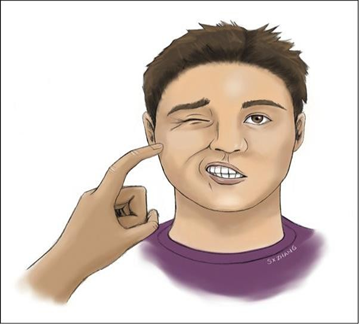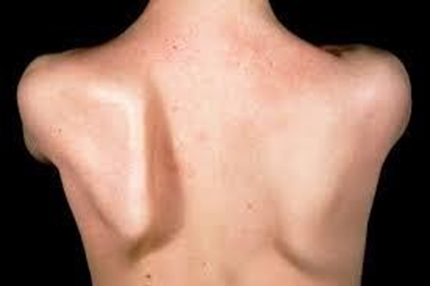A nurse is collecting data from a client who has hypomagnesemia. Which of the following findings should the nurse identify as a positive Chvostek's sign?
Image A

Image B

Image A
Image B
The Correct Answer is A
A. Chvostek's sign is a clinical sign observed during physical examination that may indicate hypocalcemia. It is elicited by tapping or lightly striking the facial nerve just anterior to
the earlobe, which can cause twitching of the facial muscles, particularly the muscles around the mouth and nose.
B. This image shows winging of the scapula. Winging of the scapula, also known as
scapular winging, is a condition characterized by the abnormal protrusion or prominence of the scapula away from the back wall of the thorax. Normally, the scapula lies flat
against the rib cage, providing stability and support for arm movements.
Nursing Test Bank
Naxlex Comprehensive Predictor Exams
Related Questions
Correct Answer is ["B","C","D"]
Explanation
A. A temperature of 37.5° C (99.5° F) is slightly elevated but can be expected postoperatively and does not typically require immediate intervention.
B. The client being difficult to arouse is concerning following opioid administration, as it may indicate over-sedation or the onset of respiratory depression. This requires immediate nursing action.
C. A respiratory rate of 10/min is low and can be a sign of opioid-induced respiratory depression, especially when combined with difficulty arousing the client. This is a critical value that
necessitates prompt nursing assessment and intervention.
D. Pulse oximetry of 88% on room air is below the normal range and indicates hypoxemia. This is a serious finding that requires immediate action to improve the client's oxygenation.
E. Pupils that are 3 mm, equal, and reactive to light, along with a blood pressure of 99/46 mm Hg, while on the lower side, are not as immediately concerning as the respiratory rate and level of consciousness.
F. A heart rate of 61/min is within normal limits and does not typically require intervention unless there are other signs of hemodynamic instability.
Correct Answer is D
Explanation
A. Confidential health information should not be disclosed to family members without the
client's consent unless there is a legal or ethical obligation to do so, such as in cases of imminent harm or emergency situations.
B. Health information should not be disclosed to an employer without the client's consent unless required by law or for specific occupational health purposes.
C. Health information should not be disclosed to an insurance agency without the client's consent unless required by law or for specific insurance-related purposes.
D. Health information may be disclosed to a medical interpreter service as necessary to facilitate communication between the client and healthcare providers. However, the interpreter should be informed of confidentiality obligations.
Whether you are a student looking to ace your exams or a practicing nurse seeking to enhance your expertise , our nursing education contents will empower you with the confidence and competence to make a difference in the lives of patients and become a respected leader in the healthcare field.
Visit Naxlex, invest in your future and unlock endless possibilities with our unparalleled nursing education contents today
Report Wrong Answer on the Current Question
Do you disagree with the answer? If yes, what is your expected answer? Explain.
Kindly be descriptive with the issue you are facing.
